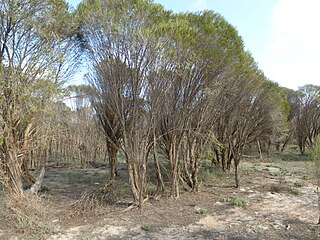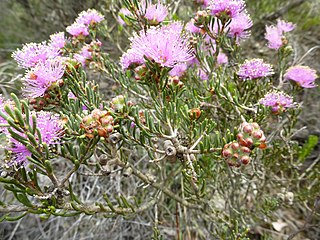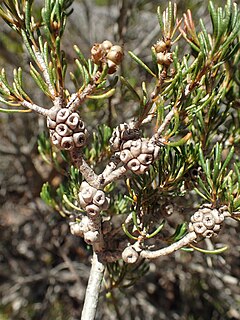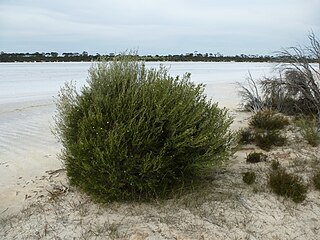
Melaleuca atroviridis is a plant in the myrtle family, Myrtaceae and is endemic to the south-west of Western Australia. It was formerly included in the species Melaleuca uncinata but a review of that species lead to the identification of a number of new species. Like M. uncinata, this species is used for the production of brushwood fencing. It has fewer stamens in the flowers and somewhat smaller clusters of fruit but has the same needle-like leaves with a hooked end and spikes of creamy yellow flowers in early summer.

Melaleuca carrii is a plant in the myrtle family, Myrtaceae and is endemic to the south-west of Western Australia. It is a small shrub similar to Melaleuca pentagona, with "pom-pom" heads of pinkish flowers and sharply pointed leaves but it is generally smaller, lacks a groove in its leaves and retains its petals on the flowers for longer than that species.

Melaleuca clavifolia is a plant in the myrtle family, Myrtaceae and is endemic to the south-west of Western Australia. It is a small shrub similar to Melaleuca tinkeri, with "pom-pom" heads of pinkish flowers and soft, silky hairs on the new growth but it has larger flower heads and its leaves are shorter, more club-shaped and have less distinct oil glands.
Melaleuca eulobata is a plant in the myrtle family, Myrtaceae and is endemic to the west coast of Western Australia. It is a shrub resembling Melaleuca campanae with its heads of pink flowers in late spring but is distinguished from that species by its sepals - in M. campane these are reduced to a ring of tissue but M. eulobata has distinct calyx lobes.

Melaleuca exuvia is a plant in the myrtle family, Myrtaceae and is endemic to the south of Western Australia. It is easily distinguished by its unusual rough, minni ritchi bark which peels to reveal a new layer of smooth, salmon-pink bark. It is a newly described (2004) species which was formerly included in Melaleuca uncinata.

Melaleuca fabri is a plant in the myrtle family, Myrtaceae and is endemic to the south-west of Western Australia. It features strap-like leaves with distinct veins and spikes of pinkish flowers, the buds of which are covered with short, soft, silky hairs.

Melaleuca halophila is a plant in the myrtle family, Myrtaceae and is endemic to the south of Western Australia. It is a prickly shrub, similar to Melaleuca thapsina but its flowers are white and the leaves are shorter and hairier.
Melaleuca idana is a plant in the myrtle family, Myrtaceae, and is endemic to the south-west of Western Australia. It is a small shrub with fine, silky hairs covering the new foliage and heads of pink to deep purple flowers in early spring. It is similar to Melaleuca sapientes, differing mainly in the shape of the leaves in cross-section and the length of its styles.
Melaleuca keigheryi is a shrub in the myrtle family, Myrtaceae with white, papery bark and is endemic to the west coast of Western Australia. In spring, it has heads of pink flowers which fade in color to become white.

Melaleuca linguiformis is a plant in the myrtle family, Myrtaceae and is endemic to the south of Western Australia. It is a shrub with hairy new growth, small leaves and heads of white flowers similar to Melaleuca teuthidoides shorter sepals and more stamens in each flower.

Melaleuca osullivanii is a plant in the myrtle family, Myrtaceae and is endemic to the south-west of Western Australia. It was first formally described in 2004 after a review of the broombush group, Melaleuca uncinata. It differs from others in the group by having leaves that are fine and circular in cross section. The closest other broombrush is Melaleuca hamata whose leaves are 0.8–1.6 mm (0.03–0.06 in) in diameter compared to 0.7–0.9 mm (0.03–0.04 in) for this species.

Melaleuca phoidophylla is a plant in the myrtle family, Myrtaceae and is endemic to the south-west of Western Australia. It is distinguished by its leaf arrangement, small raised blisters on the leaves and heads of white or cream flowers on the ends of the branches in spring.

Melaleuca podiocarpa is a plant in the myrtle family, Myrtaceae and is endemic to the south-west of Western Australia. It is a spreading shrub with prickly foliage and small heads of white flowers mostly hidden within the foliage.
Melaleuca similis is a plant in the myrtle family, Myrtaceae and is endemic to the south west of Western Australia. It is a small shrub, similar to Melaleuca stramentosa with its narrow, almost cylindrical leaves and heads of pink to purple flowers but lacks the matted, silky hairs on the young leaves and outer edge of the flower cup.

Melaleuca societatis is a plant in the myrtle family, Myrtaceae and is endemic to the south west of Western Australia. It is a dwarf shrub with small, fleshy leaves and many heads of pink or purple flowers in spring, followed by "soccer-ball" fruit.
Melaleuca stramentosa is a plant in the myrtle family, Myrtaceae and is endemic to the south-west of Western Australia. It is a small, bushy shrub similar to Melaleuca similis with its cylindrical leaves and heads of pink to purple flowers but differs in have matted, woolly hairs around the flowers and on the young leaves.
Melaleuca venusta is a shrub in the myrtle family Myrtaceae and is endemic to the west coast of Western Australia. It is a shrub with silvery leaves and heads of pink to purple flowers which fade to white and with a restricted distribution, north of the Murchison River district.

Melaleuca vinnula is a plant in the myrtle family Myrtaceae and is endemic to the south-west of Western Australia. It is a shrub with narrow leaves, heads of white to yellow flowers followed by tight clusters of fruit and it is found in the wheatbelt. It is a newly-described species from a review of the group of melaleucas known as broombrush.

Melaleuca dichroma is a shrub in the myrtle family, Myrtaceae and is endemic to the south-west of Western Australia. It is unusual for its genus in that its flowers are yellow or creamy-white but age to a pinkish-red.

Melaleuca plumea is a shrub in the myrtle family, Myrtaceae, and is endemic to the south of Western Australia. It is a widely spreading, densely foliaged shrub which produces masses of deep pink flowers in spring and early summer. Fluffy hairs on parts of the flowers, including the bracts covering the flower buds, are also a feature.

















